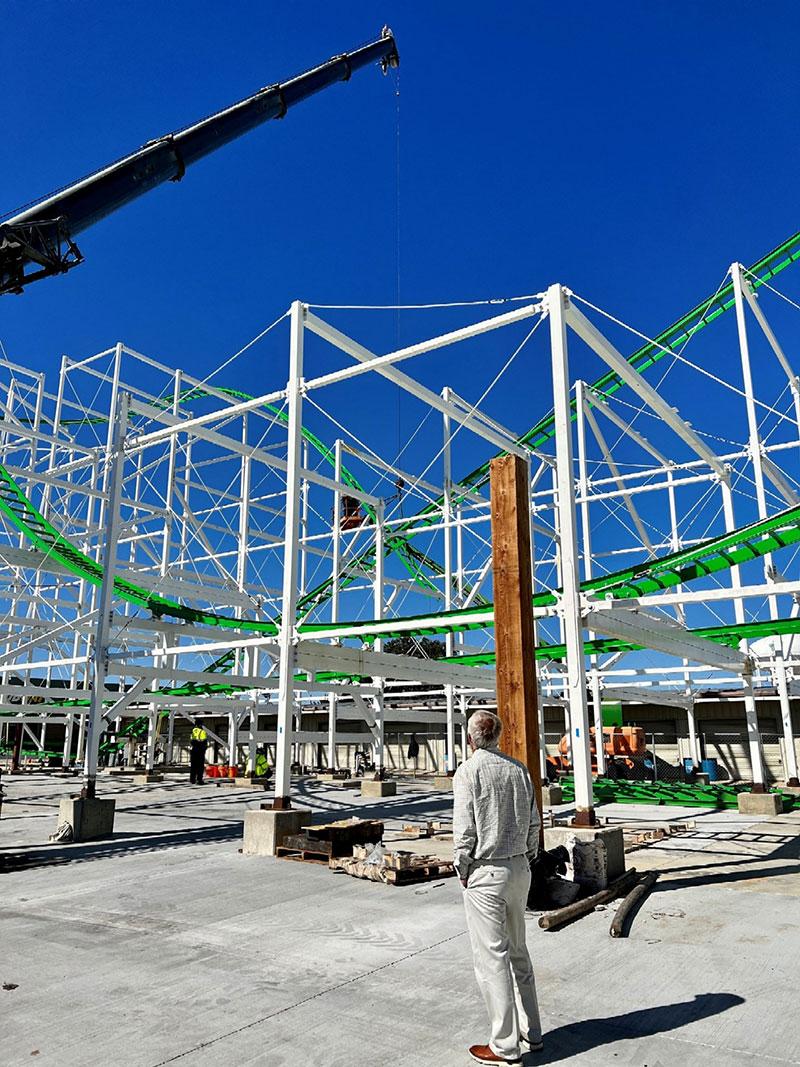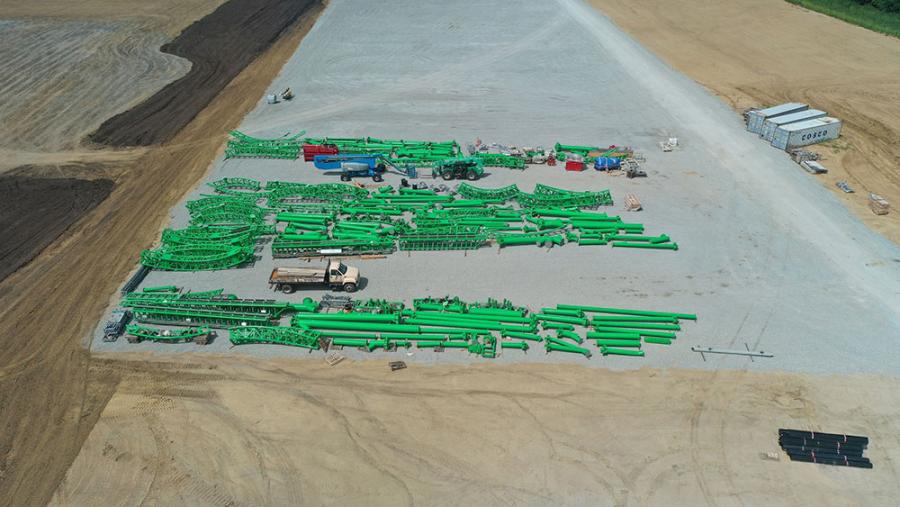Relocating a Roller Coaster Demands Careful Consideration

In the wake of the closures and restricted operations at amusement attractions caused by the COVID-19 pandemic, opening a new roller coaster could provide a significant attendance boost to any facility. While many attractions are building new, highly anticipated roller coasters, some have decided to relocate existing coasters to their facilities to give the scream machines a second life.
There are several elements for attractions contemplating a relocation to consider before deciding if a coaster fits the facility’s needs, including costs, refurbishments, guest demographics, layout, and topography. Saving on costs can be an overriding consideration, but determining whether a relocation is less expensive than starting from scratch, and just how much the savings will be, can be challenging.
Lost Island Waterpark has operated in Waterloo, Iowa, United States, for more than 20 years, and in 2019, the family-owned park announced plans to build Lost Island Themepark adjacent to the outdoor water park, with the expansion set to open in 2022. The theme park’s new rides include two roller coasters relocated from outside the country—an Intamin steel launch coaster from Liseberg park in Sweden and a Vekoma SLC from Ratanga Junction in South Africa—to be named “Matugani” and “Nopuko,” respectively.
About the challenges of relocating the coasters, Eric Bertch, the park’s owner and general manager, says, “The most frustrating part was encountering all the unexpected additional repairs and required equipment, which stemmed from our lack of experience with these rides. With all the improvements, the coasters are virtually new rides.”
Nonetheless, he says it was a good financial decision.
“We did the math, and even with the unexpected additional equipment costs we’ve encountered, the refurbished coasters still cost us less than new ones,” he explains. “Relocating, refurbishing, and troubleshooting an old ride carries a number of challenges we’d have avoided by purchasing new, but the money we saved was worth the extra work. Barring any additional surprises, we saved roughly 25% off the sticker price for new.”
Perhaps surprisingly, Bertch says dismantling the coasters and moving them from overseas wasn’t a grim experience because Lost Island retained a reputable firm for the work.
“Honestly, our refurbishing team from Swiss Ride Services did an incredible job of coordinating everything, from teardown to installation,” he says. “Since both coasters came from outside the country, there were a number of discussions with the manufacturers about updating the power supply, control systems, and ride vehicles to meet U.S. standards.”
However, dismantling and moving a coaster can sometimes be a difficult process, as the new Cotaland park at Circuit of the Americas in Austin, Texas, U.S., discovered when it decided to purchase and relocate a Schwarzkopf Wildcat coaster from Lightwater Valley Family Adventure Park in England. “There have been numerous challenges,” says Matt Hughey, senior manager at Cotaland. “First, we had to get the ride out of the building it was in by removing the roof, and the work was in tight surroundings.”
When time came to rebuild the coaster, since it had come from another country, Cotaland faced the task of ensuring it met Texas state codes and standards. Hughey tells Funworld that all of the ride’s motors were rewound, the control system was updated, and the entire coaster was repainted. He says Worldwide Safety Group assisted in overseeing the construction and inspection of the ride, which is called “Texas Wildcat.”

Making a Statement by Being the First
For Traders Village in Grand Prairie, Texas, U.S., near Dallas, the option of relocating a roller coaster instead of having to purchase a new one is al-lowing it to become the first flea market in the United States to open a major roller coaster.
“At Traders Village, we are in the flea market business, so recycling and repurposing things are at the core of what we do,” quips Traders Village President Tim Anderson. “It just made sense to save this iconic ride and give it a new life as the ‘Prairie Screamer.’”
The E&F Miler Industries steel coaster was named the “Screamer” in its first life at Scandia Amusement Park in Ontario, California, U.S., where it opened in 1995. But now, the 2,750-foot-long ride will be the star attraction among the flea market’s dozen rides.
“Purchasing the [coaster] made a tremendous amount of sense for a number of reasons,” Anderson says. “First, it was a perfect fit, size-wise, for our proposed site. Second, the ride is a great fit for our demographic—family-oriented, but with a little kick. Third, the ride had a great reputation.”
He adds that the coaster has been restored to “better than its original, new condition” in a process that took more than a year, with International Leisure Consultants providing the refurbishment expertise. E&F Miler Industries has completely restored the trains, a new lap bar and seatbelt system has been installed, and almost every major component has been replaced. “Restoring it hasn’t been a cheap date,” Anderson jokes, “but I would say that we saved 40% to 45%, versus buying a similar ride new.”
Both Cotaland and Traders Village are in the position of having not only “new-to-them” coasters to market to their guests, but ones that are also historically significant. “Texas Wildcat” is the only 45m Schwarzkopf Wildcat still operating, and “Prairie Screamer” is the only Hi-Miler 88-foot Scandia Screamer in existence.
Anderson says Traders Village will talk about “Prairie Screamer” being a one-of-a-kind roller coaster “when it’s appropriate.” Regarding “Texas Wildcat’s” status, Hughey says, “We know and understand the historic value of owning the only 45m Schwarzkopf Wildcat left in operation. We’ll be highlighting that fact with its signage and marketing.”
- Contact Funworld News Editor Keith Miller at [email protected].
Do It Right
Tim Anderson, president of Traders Village; Eric Bertch, owner and general manager of Lost Island; and Matt Hughey, senior manager of Cotaland, provide some crucial points attractions should consider before deciding to relocate a roller coaster:
- Determine if the ride truly fits your needs.
- The price you pay for the existing ride itself may be less than half the final cost. Be prepared for surprise costs and have a significant contingency fund available.
- Engage a good consultant to review the ride before purchasing, and retain someone with a proven track record of relocating used rides to minimize potential headaches.
- Have the ride inspected thoroughly so you know the cost up front. What will it take to maintain the used ride? Are parts still available?
- Understand the differences in local conditions that drive the type of foundation required.
- Check with local government to see what is needed for the ride to meet current codes.
- Allow for plenty of extra time as things don’t always go as planned.
